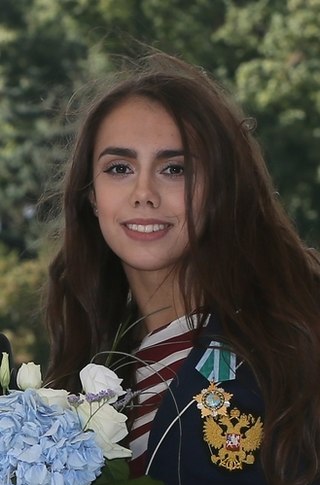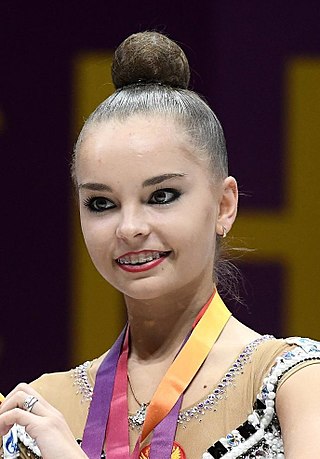
The ribbon is an apparatus used in the sport of rhythmic gymnastics. It is one of the five apparatuses utilized in this discipline, alongside the ball, clubs, hoop, and rope.

The ribbon is an apparatus used in the sport of rhythmic gymnastics. It is one of the five apparatuses utilized in this discipline, alongside the ball, clubs, hoop, and rope.
The ribbon was popularized by dancer Asaf Messerer, who was inspired by seeing Chinese acrobats dance with silk ribbons. In the 1940s, he began incorporating a ribbon into his choreography. The ribbon became a rhythmic gymnastics apparatus in 1971. [1] From 2001-2012, each apparatus had a compulsory body group of movements that had to predominate in the exercise; for ribbon, this was pivots (turns). [2]

The official specifications for the ribbon are as follows: [3]
The handle can be of any color and may be made of wood, bamboo, metal, or a synthetic material, such as fiberglass. It has a maximum diameter of 1 cm (2/5") at its widest, a cylindrical or conical shape, and may have an anti-slip grip with a maximum length of 10 cm (4"). The ribbon itself is made of satin or another similar cloth, and can be of any color. It may be multicolored and have designs on it, and it is doubled over for a length of 1m and sewn down along both edges at the end that attaches to the handle. A thread or ring swivel attaches the ribbon to the handle. [4]
Rhythmic gymnastics routines require the ribbon to constantly be in motion and create defined shapes. [3] The ribbon is generally held by the handle with the thumb and pointer finger extended. [5] Because of the ribbon's length, the gymnast can easily become tangled in it or cause knots to form; juniors and beginner gymnasts may use shorter ribbons. [6] The length also makes it sensitive to currents in the air, so air conditioning is typically turned off while the ribbon is being competed; temperatures in the arena at the 2023 World Championships reached 35 °C (95 °F) during the qualification round that included ribbon. [7] Penalties are taken for continuing to perform after a knot has formed without undoing the knot or for allowing the end of the ribbon to lie static on the floor. [8]
Gymnasts perform a variety of elements with the ribbon, including throwing the ribbon high in the air, throwing the ribbon stick and then pulling it back by the end of the ribbon fabric, and creating different patterns with the movement of the ribbon. During the exercise, the gymnast should primarily perform elements that are specific to the ribbon. The elements that are considered to be particular to the ribbon are: [8]

| venue = Gymnasium | olympic = Yes, Summer Olympics | paralympic = }} Gymnastics is a type of sport that includes physical exercises requiring balance, strength, flexibility, agility, coordination, artistry and endurance. The movements involved in gymnastics contribute to the development of the arms, legs, shoulders, back, chest, and abdominal muscle groups. Gymnastics evolved from exercises used by the ancient Greeks that included skills for mounting and dismounting a horse, and from circus performance skills.

In gymnastics, the floor is a specially prepared exercise surface, considered an apparatus. The floor exercise is the event performed on the floor, in both women's and men's artistic gymnastics. The same floor is used for WAG FX and MAG FX, but rules and scoring differ; most obviously, a WAG FX routine is synchronised to a piece of recorded dance music, whereas MAG FX has no musical accompaniment.

Rhythmic gymnastics is a sport in which gymnasts perform individually or in groups on a floor with an apparatus: hoop, ball, clubs, ribbon and rope. The sport combines elements of gymnastics, dance and calisthenics; gymnasts must be strong, flexible, agile, dexterous and coordinated. Rhythmic gymnastics is governed by the International Gymnastics Federation (FIG), which first recognized it as a sport in 1963. It became an Olympic sport in 1984 with an individual all-around event. The group all-around competition was added to the Olympics in 1996. At the international level, rhythmic gymnastics is a women-only sport. The most prestigious competitions, besides the Olympic Games, are the World Championships, World Games, European Championships, European Games, the World Cup Series and the Grand Prix Series. Gymnasts are judged on their artistry, execution of skills, and difficulty of skills, for which they gain points. They perform leaps, balances, and rotations along with handling the apparatus.

The ball is an apparatus used in the sport of rhythmic gymnastics. It is one of the five apparatuses utilized in this discipline, alongside the clubs, hoop, ribbon, and rope.

The clubs are an apparatus used in the sport of rhythmic gymnastics. They are one of the five apparatuses utilized in this discipline, alongside the ball, hoop, ribbon, and rope.

The hoop is an apparatus used in the sport of rhythmic gymnastics. It is one of the five apparatuses utilized in this discipline, alongside the ball, clubs, ribbon, and rope.

The rope is an apparatus used in the sport of rhythmic gymnastics. They are one of the five apparatuses utilized in this discipline, alongside the ball, clubs, hoop, and ribbon. While previously used at both the senior and junior level and in both individual and group exercises, the rope has been mostly phased out of usage and is now only used in the junior group exercises in some years.

Twirling is a form of object manipulation where an object is twirled by one or two hands, the fingers or by other parts of the body. Twirling practice manipulates the object in circular or near circular patterns. It can also be done indirectly by the use of another object or objects as in the case of devil stick manipulation where handsticks are used. Twirling is performed as a hobby, sport, exercise or performance.
Lilia Ignatova is a Bulgarian modern rhythmic gymnast. She was one of the Golden Girls of Bulgaria who dominated rhythmic gymnastics in the 1980s.
This is a general glossary of the terms used in the sport of gymnastics.

Gymnastics Australia (GA) is the governing body for the sport of gymnastics in Australia.

Neta Rivkin is a retired Israeli individual rhythmic gymnast.

Margarita Mamun is a retired Russian individual rhythmic gymnast of Bangladeshi-Russian descent. She is the 2016 Olympic All-around champion, two-time World All-around silver medalist, the 2015 European Games All-around silver medalist, the 2016 European Championships All-around silver medalist, three-time Grand Prix Final All-around champion and a three-time (2011–2013) Russian National All-around champion.

Yana Alexeyevna Kudryavtseva is a retired Russian individual rhythmic gymnast. She is the 2016 Olympic All-around silver medalist, three-time World Champion in the All-around (2013–2015), the 2015 European Games All-around champion, two-time European Championships All-around champion, the 2012 European Junior ball champion. In national level, she is a two-time Russian National All-around champion and three time Russian Junior National all-around champion.
Aesthetic group gymnastics (AGG) is a discipline of gymnastics developed from Finnish "Women's Gymnastics" (naisvoimistelu). The discipline is reminiscent of rhythmic gymnastics, with some significant differences: in AGG, the emphasis is on big and continuous body movement, and the teams are larger. AGG teams often consist of 4–10 gymnasts, and some children’s teams are bigger. Furthermore, apparatus is not used in international AGG competitions as it is in rhythmic gymnastics where balls, ribbons, hoops and clubs are used on the floor area. The sport requires physical qualities such as flexibility, balance, speed, strength, coordination and sense of rhythm where movements of the body are emphasized in the flow and, expressive and aesthetic appeal. A good performance is characterized by uniformity and simultaneity. The competition program consists of versatile and varied body movements, such as body waves and swings, balances and pivots, jumps and leaps, dance steps, and lifts.

Arina Alekseyevna Averina is a Russian former individual rhythmic gymnast. She was a 2020 Summer Olympics finalist, a two-time world all-around silver medalist, a two-time European all-around champion and the 2016 Grand Prix Final all-around bronze medalist. She was a three-time (2019–2021) Russian national all-around champion and a three-time Russian national all-around medalist. Her identical twin sister Dina Averina is also a competitive rhythmic gymnast.
The 30th Rhythmic Gymnastics European Championships took place from June 10 to June 15, 2014 at the then newly opened National Gymnastics Arena in Baku, Azerbaijan. 33 participating federations with their juniors and seniors gymnasts participated at the event.
Alexandra Ana Maria Agiurgiuculese is a Romanian-Italian individual rhythmic gymnast who represents Italy. She is a World Championships silver and bronze medalist, and she competed at the 2020 Summer Olympics. Agiurgiuculese was the first Italian gymnast to win the Longines Prize for Elegance. At the national level, she is the 2019 Italian National all-around champion and three-time Italian National all-around silver medalist.

Daria Sergeyevna Trubnikova is a retired Russian individual rhythmic gymnast. She is the 2018 Youth Olympic Games individual all-around champion, the 2018 European Junior Clubs and Team champion, the 2019 Grand Prix Final all-around gold medallist and the 2021 World Cup Baku all-around gold medallist. On the national level, she is the 2018 Russian Junior all-around bronze medalist. In January 2023, Trubnikova announced her retirement.

Ekaterina Olegovna Vedeneeva is a Russian-born Slovenian individual rhythmic gymnast.